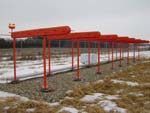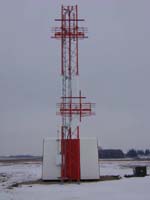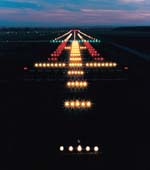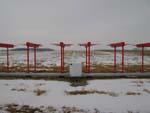

Austin Gets New ILS |
||
|
What is it? The Instrument Landing System (ILS) is a ground-based navigational aid that provides precise guidance to a runway or heliport. It is commonly refered to as an "ILS approach". There are four major components to the ILS: the localizer, glide slope, distance markers, and the approach lighting system. The localizer is used to provide, a properly equiped aircraft, horizontal guidance to a specific runway or heliport. In other words, the pilot can determine if the aircraft is left or right of course based on the cockpit instrument's reception of the localizer. You may hear of a different type of approach called a "localizer approach". This type of approach uses the same equipment as an ILS but excludes the glide slope. |
 |
 |
As the localizer is providing horizontal guidance, the glide slope issues vertical guidance. This vertical guidance is what makes and ILS approach a precision approach. The glide slope establishes an exact descent profile that, in most cases, allows a pilot to safely descend to within two hundred feet of the ground. Distance information may come from a few different pieces of equipment. Some ILS approaches have marker beacons. Marker beacons are designed to give an audible and visual cue in the aircraft cockpit in as many as three different places along the ILS final approach path. Not all ILS approaches have marker beacons. Some may have DME associated with them, while others use crossing radials off of other navigational aids to indicate distance. The final component of the ILS is the lighting system. Although the instrumentation has the ability to guide an aircraft very close to the runway, in the end the pilot still needs to be able to see the runway in order to land the aircraft. This is where the lighting system comes in to play. There are many different combinations of lights ranging from very simple to very complex. |
 |
How can it help? When all four of the ILS components are banded together, they can make a very powerful tool for a pilot flying in Instrument Meteorological Conditions (IMC). The system provides very precise guidance, through cloud cover, to a point approximately 200 feet off the ground and just at the end of the runway. This makes any airport a much more suitable destination. |
||
Who paid for it? This ILS installation at the Austin Airport was funded by the State of Minnesota. Under the Airport Improvement Program (AIP) the state provides grants to public-use airports through-out the state in order to improve conditions for aircraft operators from around the country. The money for these grants is collected through the Airport and Airway Trust Fund. This trust fund is generated from aviation user fees and fuel taxes. The fund was designed to use aviation taxes to improve aviation assets. This means that very little contribution is required from state or even federal general funds to make aviation advancements. |
||
Privacy Policy | Copyright Information | Contact Webmaster
